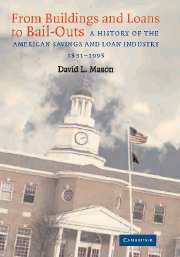 From Buildings and Loans to Bail-Outs
From Buildings and Loans to Bail-Outs Book contents
- Frontmatter
- Contents
- List of Tables
- Acknowledgments
- Introduction
- 1 A Movement Takes Shape, 1831–1899
- 2 The Rise of the League, 1900–1929
- 3 From State to Federal Oversight
- 4 The Movement Becomes an Industry, 1930–1945
- 5 The Glory Years, 1946–1955
- 6 External Challenges and Internal Divisions, 1956–1966
- 7 Lost Opportunities, 1967–1979
- 8 Deregulation and Disaster, 1979–1988
- 9 Resolving the Crisis, Restoring the Confidence, 1989–1995
- 10 The American Savings and Loan Industry in Perspective
- Appendices
- Bibliography
- Index
7 - Lost Opportunities, 1967–1979
Published online by Cambridge University Press: 29 October 2009
- Frontmatter
- Contents
- List of Tables
- Acknowledgments
- Introduction
- 1 A Movement Takes Shape, 1831–1899
- 2 The Rise of the League, 1900–1929
- 3 From State to Federal Oversight
- 4 The Movement Becomes an Industry, 1930–1945
- 5 The Glory Years, 1946–1955
- 6 External Challenges and Internal Divisions, 1956–1966
- 7 Lost Opportunities, 1967–1979
- 8 Deregulation and Disaster, 1979–1988
- 9 Resolving the Crisis, Restoring the Confidence, 1989–1995
- 10 The American Savings and Loan Industry in Perspective
- Appendices
- Bibliography
- Index
Summary
From the inclusion of thrifts under Regulation Q to the onset of deregulation, the business environment for S&Ls grew increasingly more complex. A major reason for this situation was that the economy of the 1970s was very unstable, characterized by slow growth, rising inflation, and high interest rates. This condition, called “stagflation,” forced thrifts to redesign traditional mortgages to make them affordable to borrowers, and create new savings instruments to attract funds from investors. A second factor was that technological innovations revolutionized finance and dramatically altered the way in which consumers could use their money. While many of these changes benefited the thrift industry, they also led to greater competition with other financial intermediaries. Finally, the rise of a consumer movement forced lenders to pay more attention to the problem of lending discrimination and be more responsive to the needs of individuals and communities. This not only led to the passage of several pro-consumer laws, but also gave consumers more agency in how S&Ls conducted business. While S&Ls continued to expand and maintain their dominant role as mortgage providers during these difficult years, such broad changes in the marketplace led the League and government officials to reassess the basic structure of thrift regulation. Nonetheless, conflicts over different issues, both within the industry and from other interest groups, delayed any substantive action for years.
- Type
- Chapter
- Information
- From Buildings and Loans to Bail-OutsA History of the American Savings and Loan Industry, 1831–1995, pp. 187 - 212Publisher: Cambridge University PressPrint publication year: 2004


